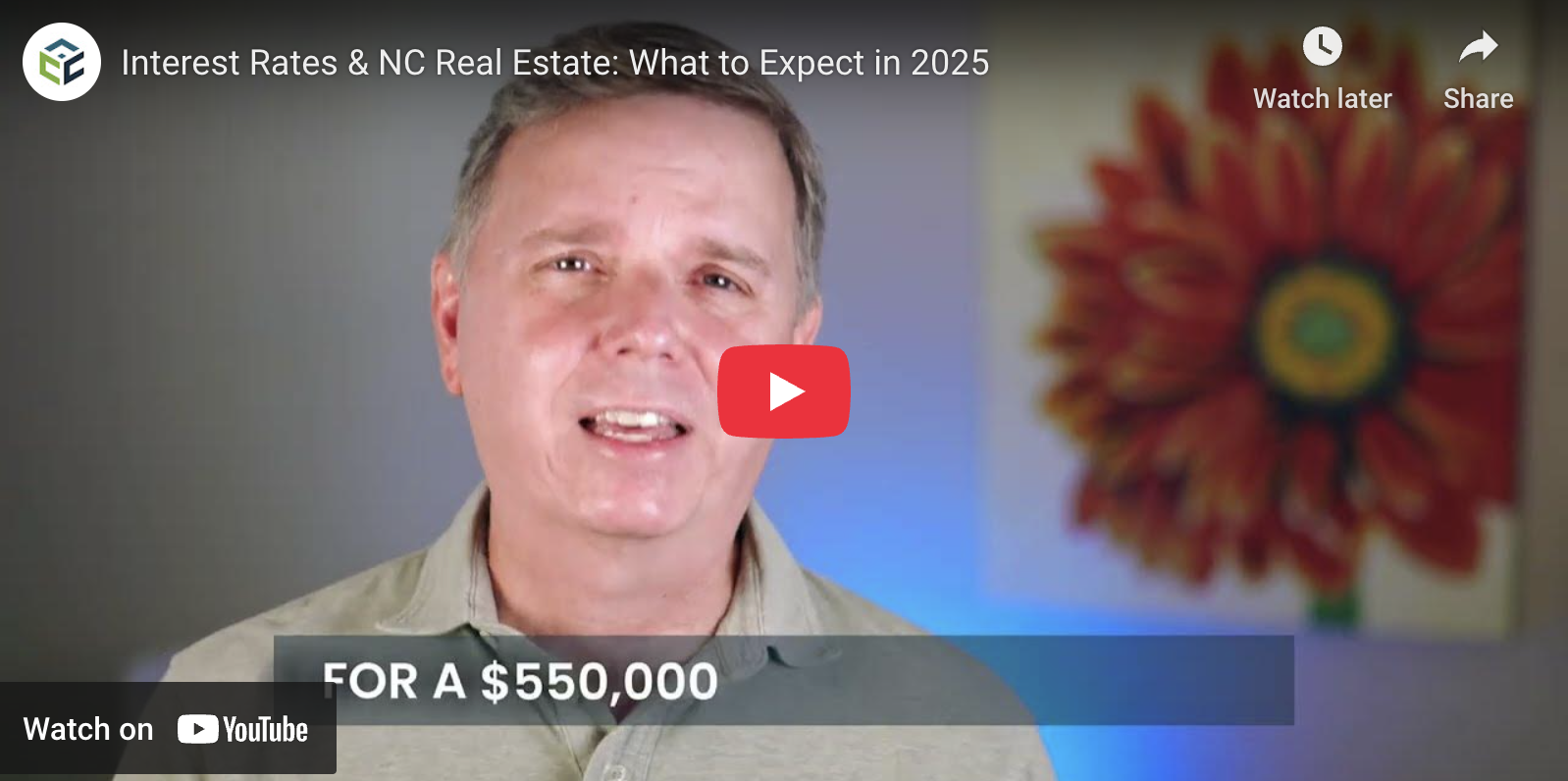Current Rates: 30-year fixed mortgage rates in North Carolina are around 6.88% as of July 2025, slightly below the national average.
Forecast: Experts suggest rates may drop to 6.2%–6.8% by year-end, though economic uncertainties like tariffs could delay cuts.
Market Trends: Home prices are up 1.3% year-over-year to a median of $395,600, with inventory rising 20.9%, creating a balanced market.
Expert Insights: Federal Reserve Chair Jerome Powell and industry experts emphasize caution due to inflation and tariff risks, impacting rate cut timing.
Opportunities: Buyers gain negotiation leverage with increased inventory, while sellers can benefit from strong demand in areas like the Triangle.
Understanding Interest Rates in 2025
As of July 22, 2025, North Carolina’s 30-year fixed mortgage rates hover around 6.88%, per Bankrate. This translates to a monthly payment of about $3,550 for a $550,000 home. Experts, including Fannie Mae, predict a potential decline to 6.2% by year-end, which could lower payments to around $3,450, saving buyers approximately $100 monthly [1]. However, Federal Reserve Chair Jerome Powell’s cautious stance on rate cuts, driven by inflation and tariff concerns, suggests delays until at least September 2025 [2].
Real Estate Market Dynamics
The North Carolina housing market is stabilizing, with home prices up 1.3% year-over-year to a median of $395,600 in June 2025, according to Redfin [5]. Inventory has increased by 20.9%, and homes are staying on the market longer (42 days on average), giving buyers more options and negotiation power. The Triangle area (Raleigh, Durham, Chapel Hill) remains a hotspot due to strong job growth, but a balanced market offers opportunities for both buyers and sellers.
Expert Perspectives
Jerome Powell, in his June 2025 testimony, emphasized a wait-and-see approach, stating, “For the time being, we are well positioned to wait to learn more about the likely course of the economy before considering any adjustments to our policy stance” [4]. Local expert Robbie Perkins noted, “The market is strong, but we need innovative solutions like repurposing commercial spaces to meet demand” [6]. These insights highlight the need for strategic timing in real estate decisions.
Advice for Buyers and Sellers
Buyers can leverage increased inventory to negotiate better deals, while exploring financing options like adjustable-rate mortgages. Sellers should price competitively and enhance property appeal to stand out in a market with growing supply. Working with local experts, like Carolina’s Choice Real Estate, can help navigate these trends. Contact them at (919) 844-1152 to seize opportunities in this dynamic market.
Introduction
North Carolina’s real estate market in 2025 is a dynamic landscape shaped by interest rates, economic policies, and regional growth. As of July 2025, the market is balanced, with moderate price appreciation and rising inventory creating opportunities for both buyers and sellers. Interest rates, a critical factor, are influenced by Federal Reserve policies and economic uncertainties like tariffs. This blog explores current rates, expert forecasts, and market trends, incorporating insights from Federal Reserve Chair Jerome Powell and industry professionals to guide your real estate decisions in North Carolina, particularly in the vibrant Triangle area (Raleigh, Durham, Chapel Hill).
Current Interest Rates in North Carolina
As of July 22, 2025, the average 30-year fixed mortgage rate in North Carolina is 6.88%, slightly below the national average of 6.91%, according to Bankrate [1]. The 15-year fixed rate is 6.08%, and FHA loans average 7.008% [4]. For a $550,000 home, a 6.88% rate results in a monthly payment of approximately $3,550, based on standard mortgage calculations. These rates reflect a stabilization from the 7%+ peaks of 2023 and early 2024, driven by cooling inflation, which rose 0.1% from April to May 2025, with a year-over-year increase of 2.4% [2].
Historically, rates were as low as 2.65%–3.29% during the pandemic-era policies of 2020–2021, making today’s rates relatively high but manageable compared to the 6%–7% range of the early 2000s [1]. The slight decline from June’s 6.9% offers modest relief for borrowers, but economic factors continue to influence rate movements.
Interest Rate Forecasts for 2025
Experts offer varied predictions for interest rates by the end of 2025. Fannie Mae’s June 2025 Housing Forecast projects a decline to 6.2% for 30-year fixed mortgages, potentially reducing monthly payments for a $550,000 home by about $100 [1]. The Mortgage Bankers Association (MBA) anticipates rates at 6.7%, while Long Forecast suggests a possible drop to 6.37% by December 2025 [3]. However, economic uncertainties, including President Trump’s proposed tariffs, could delay significant rate cuts until at least September 2025 [2]. Melissa Cohn of William Raveis Mortgage notes, “Mortgage rates will continue to fall slowly as oil prices fall and inflation data remains muted” [1].
Source | Predicted 30-Year Fixed Rate (End of 2025) | Source URL |
|---|---|---|
Fannie Mae | 6.2% | Bankrate |
Mortgage Bankers Association | 6.7% | Forbes Advisor |
Long Forecast | 6.37% | Long Forecast |
National Association of Home Builders | 6.75% | Forbes Advisor |
Jerome Powell’s Recent Testimony
In his June 2025 congressional testimony before the House Financial Services Committee and Senate Banking Committee, Federal Reserve Chair Jerome Powell emphasized a cautious approach to monetary policy. He stated, “For the time being, we are well positioned to wait to learn more about the likely course of the economy before considering any adjustments to our policy stance” [4]. The current federal funds rate is approximately 4.3%, unchanged since late 2024 due to concerns over tariff-driven inflation [2]. Powell highlighted that inflation, measured by PCE prices, was 2.3% total and 2.6% core (excluding food and energy) for the 12 months ending May 2025, slightly above the Fed’s 2% target [4]. Some Fed members, like Michelle Bowman and Christopher Waller, suggested a possible rate cut as early as July 2025, but a significant minority project no cuts or only one this year [2].
Powell’s testimony underscores the Fed’s focus on balancing its dual mandate of maximum employment and stable prices, with tariffs posing a risk of persistent inflation. This cautious stance suggests that significant mortgage rate reductions may not occur until late 2025 or early 2026, impacting real estate affordability.
North Carolina Real Estate Market Overview
The North Carolina housing market in 2025 is stabilizing, with home prices up 1.3% year-over-year to a median of $395,600 in June 2025, per Redfin [5]. Sales activity is robust, with 14,207 homes sold in June 2025, a 5.7% increase from 13,443 in June 2024. Homes are staying on the market longer, averaging 42 days, up 9 days from last year, indicating a shift toward a more balanced market [5]. Inventory has surged 20.9% year-over-year, providing buyers with more options and reducing the intense competition seen in prior years [5].
In the Triangle area, demand remains strong due to job growth in technology, healthcare, and education, with the region’s population growing by 1.5% from July 2023 to July 2024, adding 165,000 residents [8]. However, homes in Raleigh sold for a median of $440,000 in May 2025, down 0.45% year-over-year, with an average of 35 days on the market [7]. In Charlotte, the median price was $426,770, up 2.7% since last year, with 4,180 homes for sale [8].
Metric | June 2025 (Redfin) | January 2025 (Bankrate) |
|---|---|---|
Median Home Price | $395,600 | $367,800 |
Inventory Increase (YoY) | 20.9% | 22.6% |
Homes Sold (YoY) | +5.7% | +5.1% |
Days on Market | 42 days | 63 days |
Expert Commentary on the Market
Local real estate expert Robbie Perkins highlighted innovative solutions for North Carolina’s market, stating, “The market is strong, but we need innovative solutions like repurposing commercial spaces to meet demand” [6]. He discussed trends in the Triad, including converting vacant office buildings into residential units to address supply constraints [6]. Industry professionals note that high demand, driven by population and job growth, continues to fuel the market, while insiders predict rents could rise 10–15% due to sluggish apartment construction [6].
Nationally, experts at Brazoban.com predict mortgage rates will hover between 6.5% and 6.8% through 2025, citing economic uncertainties like tariffs [3]. They also note an “alarming trend of investor buying,” with small investors accounting for 59% of purchases in 2024, though high rates and falling rents are prompting sales [3]. Marco Santarelli of Norada Real Estate Investments emphasizes, “The North Carolina housing market shows considerable resilience, with ongoing demand driven by new residents and strong job growth” [7].
Implications for Buyers and Sellers
For Buyers
Buyers benefit from a 20.9% increase in inventory and homes staying on the market longer (42–63 days), offering more choices and negotiation leverage [5, 1]. In January 2025, 27% of homes sold below asking price, particularly in less competitive markets [1]. However, with rates at 6.88%, buyers should consider financing options like adjustable-rate mortgages (ARMs), which offer lower initial rates, or programs like the NC Home Advantage Mortgage™ [9]. As Investopedia advises, “If you find a home you like, it’s likely wise to buy now, as rates are currently near a three-month low” [10].
For Sellers
Sellers in the Triangle can capitalize on strong demand, but the market’s balance requires competitive pricing. With 16% of homes selling above asking price in early 2025, well-prepared properties in desirable areas can command premiums [1]. Enhancing curb appeal and staging can attract buyers, as homes priced too high may linger. Sellers should be open to negotiations, as buyers seek concessions in a market with growing supply [3].
Looking Ahead: Market Predictions for Late 2025 and 2026
Experts predict moderate home price growth of 3%–4% annually in 2025, with inventory continuing to rise due to new construction and policy measures [7]. Carolina Journal notes, “Supply-side constraints require innovative solutions,” such as repurposing commercial spaces [6]. Interest rates may dip to 6.5%–6.7% by late 2025, with some optimism for 6.3%–6.4% [1, 3]. By 2026, rates could fall to 6.1%–6.27%, per Fannie Mae and the National Association of Home Builders [3]. However, Greg McBride of Bankrate cautions, “Concerns about inflation and escalating government debt will keep a high floor under rates” [11].
North Carolina’s economic strengths, including a robust job market and population growth, will sustain demand, particularly in the Triangle [8]. Remote work flexibility is attracting buyers to smaller cities, enhancing affordability [7]. New construction and economic growth will shape the market’s trajectory, but tariff policies and inflation remain key variables.
North Carolina’s 2025 real estate market offers a balanced landscape for buyers and sellers, with interest rates and inventory trends creating strategic opportunities. While rates may ease slightly by year-end, economic uncertainties require careful planning. The Triangle remains a prime destination due to its economic vitality. Whether buying or selling, partnering with experts like Carolina’s Choice Real Estate can ensure success. Contact them at (919) 844-1152 to navigate this dynamic market with confidence.
Citations
[1] Bankrate: Current North Carolina Mortgage & Refinance Rates
[3] Brazoban.com: Weekly Real Estate Market Recap - June 16, 2025
[6] Carolina Journal: NC’s real estate market: Key trends shaping 2025 and beyond
[7] Norada Real Estate Investments: North Carolina Housing Market: Trends and Forecast 2024-2025
[8] RealWealth: North Carolina Housing Market Predictions for 2025 & 2026
[10] Investopedia: What To Expect From Fed Chair Powell’s Congressional Testimony


